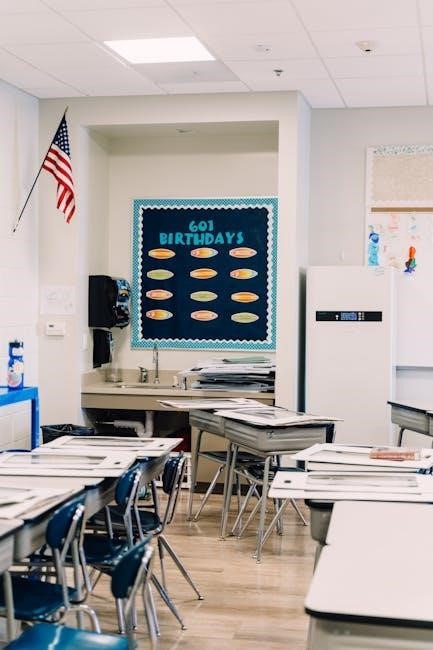ELA bell ringers are short, engaging activities that kickstart middle school English classes, focusing on vocabulary, grammar, and reading skills to enhance academic readiness and student focus.
1.1 Definition and Purpose of Bell Ringers in ELA
Bell ringers in ELA are short, engaging activities designed to begin class, focusing on vocabulary, grammar, or reading skills. They serve as a warm-up to prepare students for learning, fostering a structured start to lessons. These activities are typically brief, lasting 5-10 minutes, and aim to capture students’ attention while reinforcing essential skills. The purpose of bell ringers is to establish a routine, promote active participation, and provide consistent practice in key ELA areas. They also help teachers assess student understanding and address gaps in knowledge early. By incorporating free PDF resources, educators can easily access and distribute these activities, making them a practical and effective tool for middle school classrooms. They set the tone for a productive and focused learning environment.
1.2 Importance of Bell Ringers for Middle School Students
Bell ringers hold significant importance for middle school students as they provide a structured start to each class, fostering focus and readiness to learn. These activities help bridge gaps in knowledge by consistently reinforcing key ELA skills such as vocabulary, grammar, and reading comprehension. By engaging students immediately, bell ringers minimize distractions and create a positive classroom environment. They also offer an opportunity for individualized practice, allowing students to work at their own pace. The use of free PDF resources makes these activities accessible and easy to implement. Regular use of bell ringers helps students develop a routine, improving their time management and organizational skills. This consistent practice contributes to better academic performance and confidence in ELA subjects. Additionally, bell ringers encourage active participation, making learning more interactive and enjoyable for middle school students. They are a valuable tool for both teachers and students, promoting a smooth transition into daily lessons and fostering a love for learning.
1.3 Benefits of Using Free PDF Resources
Free PDF resources for ELA bell ringers offer numerous advantages for middle school educators and students. They provide cost-effective access to high-quality materials, ensuring that all students can benefit without financial burden. PDFs are easily downloadable, printable, and shareable, making them versatile for various classroom needs. Many resources are designed to be no-prep, saving teachers valuable time and effort. These materials often include a variety of activities, such as vocabulary building, grammar exercises, and reading comprehension tasks, which cater to diverse learning styles; Additionally, PDF resources can be used digitally or in print, offering flexibility for both in-class and remote learning environments. This accessibility ensures that bell ringer activities are consistent and engaging, supporting student progress throughout the year. Free PDF resources are a practical and efficient way to enhance ELA instruction for middle school students.

Types of ELA Bell Ringers
ELA bell ringers include activities like vocabulary building, grammar practice, reading comprehension warm-ups, and writing prompts, designed to engage students at the start of class.
2.1 Vocabulary Building Activities
Vocabulary building activities are a cornerstone of ELA bell ringers, helping students expand their lexicon. These exercises often include Word of the Day features, where a new word is introduced with its definition and usage. Students engage in activities like creating sentences, synonyms, or visual representations to reinforce understanding. Additionally, root words and affixes are explored to decode unfamiliar terms, enhancing comprehension. Free PDF resources provide structured exercises, making it easy for teachers to implement these activities. By starting the class with such warm-ups, students develop a stronger grasp of academic vocabulary, preparing them for more complex texts and discussions throughout the year. These activities are both educational and engaging, fostering a love for language learning.
2.2 Grammar Practice Exercises
Grammar practice exercises are essential for ELA bell ringers, providing students with quick, focused opportunities to review and master grammar concepts. These activities often include mentor sentences, where students analyze and correct grammatical structures. Exercises may involve identifying parts of speech, correcting punctuation errors, or rewriting sentences for clarity. Such practices help students develop a stronger command of language rules, which improves their writing and communication skills. Free PDF resources offer a variety of grammar-focused bell ringers, making it easy for teachers to incorporate these exercises into daily routines. Regular grammar practice not only reinforces foundational skills but also prepares students for more complex texts and writing tasks. Starting the class with these warm-ups sets a positive tone and ensures students are mentally prepared for the lesson ahead.
2.3 Reading Comprehension Warm-Ups
Reading comprehension warm-ups are a key component of ELA bell ringers, designed to activate students’ critical thinking and prepare them for in-depth reading tasks. These exercises often include picture inferences, where students analyze images to make predictions or draw conclusions. Additionally, short passages with guiding questions help students practice summarizing, identifying main ideas, and making connections to prior knowledge. Free PDF resources provide a variety of reading prompts, such as book recommendations and discussion starters, to engage students and foster a love for reading. Regular practice with these warm-ups enhances students’ ability to interpret and analyze texts effectively. By starting the class with these activities, teachers ensure students are focused and ready to tackle more challenging reading assignments throughout the lesson.
2.4 Writing Prompts and Journaling
Writing prompts and journaling activities are essential components of ELA bell ringers, encouraging students to express their thoughts creatively and reflect on their learning. These exercises often include journal prompts that ask students to write about personal experiences, opinions, or responses to literature. Creative writing prompts, such as crafting descriptive paragraphs or narratives, help students develop their writing voice and style. Free PDF resources provide a variety of writing activities, including reflection questions and brainstorming exercises, to inspire engagement. Journaling also allows students to track their progress and articulate their understanding of concepts. Regular writing practice builds confidence and fluency, making it an invaluable part of the ELA classroom routine. These activities are designed to be quick, meaningful, and adaptable to diverse learning needs.

Vocabulary Building Bell Ringers
Vocabulary building bell ringers introduce and reinforce academic words through activities like Word of the Day and root words practice, enhancing students’ lexical knowledge and comprehension skills.

3.1 Word of the Day Activities
Word of the Day activities are a popular bell ringer strategy that introduces students to new vocabulary daily. These activities often include definitions, synonyms, antonyms, and usage examples. Teachers can use free PDF resources to create engaging handouts or digital slides. Students can complete quick exercises like fill-in-the-blank sentences or create their own contextual sentences. This method not only expands vocabulary but also encourages critical thinking and application. Many educators incorporate images or memes to make the activities more visually appealing and relatable for middle school students. Regular practice helps students retain new words and improves their overall communication skills. This approach is both effective and easy to implement in the classroom.
3.2 Root Words and Affixes Practice
Root words and affixes practice is a key component of vocabulary-building bell ringers. These activities focus on breaking down words into their base forms and prefixes or suffixes. Free PDF resources often include exercises where students match root words with their meanings or create new words by adding affixes. This practice enhances students’ ability to decode unfamiliar vocabulary in reading and writing. Teachers can use digital tools like Google Slides or printable worksheets for quick, engaging exercises. Regular practice helps students recognize patterns and expand their lexicon. Many resources also incorporate visual aids like charts or diagrams to make learning more interactive and effective for middle school students.

Grammar Practice Bell Ringers
Grammar bell ringers provide quick, engaging exercises to review sentence structure, verb tenses, and punctuation, helping students build foundational writing and communication skills effectively.
4.1 Mentor Sentences for Grammar Review
Mentor sentences are a powerful tool for grammar review, allowing students to analyze sentence structure, grammar rules, and vocabulary in context. These sentences, often selected from literature or tailored to specific grammar concepts, encourage students to identify and discuss grammatical elements such as verb tenses, subject-verb agreement, and punctuation. By breaking down sentences, students gain a deeper understanding of how language works, improving their writing and communication skills. Many free PDF resources include mentor sentences as part of comprehensive grammar practice sets, making it easy for teachers to integrate them into daily routines. This approach not only reinforces grammar but also connects students to real-world examples, fostering engagement and retention. Additionally, mentor sentences can be paired with activities like picture inferences or book recommendations for a well-rounded ELA practice.
4.2 Inference Skills Development
Inference skills development is a crucial component of ELA bell ringers, enabling students to draw conclusions based on textual or visual cues. Activities like picture inferences and book recommendations encourage students to analyze details, make logical connections, and support their interpretations with evidence. Free PDF resources often include exercises that prompt students to infer themes, characters’ motivations, or events in a narrative. These exercises not only enhance reading comprehension but also foster critical thinking and creativity. By incorporating inference-based bell ringers, teachers can help middle school students develop a deeper understanding of texts and improve their ability to think analytically. This skill is essential for both academic success and real-world applications, making it a valuable focus of daily ELA routines.

Reading Comprehension Bell Ringers
Reading comprehension bell ringers engage students with short texts, images, or discussions, fostering critical thinking and deeper understanding of narratives and themes through structured analysis activities.
5.1 Picture Inferences and Analysis
Picture inference and analysis activities are a key component of reading comprehension bell ringers. These activities typically involve presenting students with an image or series of images, followed by questions that require them to interpret and analyze the visual content. This helps students develop their critical thinking skills and ability to draw conclusions based on visual evidence. These exercises are often included in free PDF resources for middle school ELA, providing teachers with ready-to-use materials. By engaging with these activities, students not only enhance their comprehension abilities but also learn to support their interpretations with evidence, a crucial skill for academic success. Regular practice through these bell ringers can significantly improve students’ performance in reading assessments and beyond.
5.2 Book Recommendations and Discussions
Book recommendations and discussions are an engaging way to start ELA classes, fostering a love for reading and critical thinking. Teachers often use bell ringers to introduce new titles, discuss themes, or explore genres, encouraging students to share their thoughts and opinions. These activities can be paired with free PDF resources that include discussion prompts or reading guides. By incorporating book recommendations into bell ringers, educators can help students discover diverse authors and texts while fostering a collaborative learning environment. Such discussions also provide opportunities for students to practice articulating their ideas and listening to others, enhancing both communication and comprehension skills. This approach makes reading relevant and enjoyable, preparing students for deeper literary analysis throughout the year.

Writing and Creative Expression Bell Ringers
Writing bell ringers inspire creativity and reflection through journal prompts, creative exercises, and free PDF resources, helping students express ideas and develop writing skills effectively.
6.1 Journal Prompts for Reflection
Journal prompts are an excellent way to encourage reflection and creative thinking in middle school ELA students. These prompts often focus on personal experiences, literature analysis, or current events, allowing students to express their thoughts and opinions. Many free PDF resources offer a variety of journal prompts tailored for different grade levels, making it easy for teachers to incorporate them into daily routines. Reflective journaling helps students develop writing skills, critical thinking, and self-expression. It also provides a platform for students to connect with the material and share their unique perspectives. Over time, these exercises can foster a deeper understanding of themselves and the world around them.
6;2 Creative Writing Exercises
Creative writing exercises are a dynamic way to inspire middle school students to express their imagination and develop their writing skills. These exercises often include prompts like storytelling, poetry, or dialogue writing, encouraging students to think critically and creatively. Free PDF resources provide a variety of engaging prompts tailored for different grade levels, making it easy for teachers to implement these activities. Students can craft stories based on pictures, write from different perspectives, or explore fictional scenarios. These exercises not only enhance writing abilities but also foster creativity and self-confidence. They provide a platform for students to voice their ideas and connect with their inner creativity, making learning fun and meaningful. Over time, these activities help students grow into skilled and imaginative writers.

Digital and Printable Resources
Digital and printable ELA bell ringer resources, including free PDF downloads, Google Slides, and PowerPoint options, offer no-prep activities perfect for grades 6-8.
7.1 Free PDF Downloads for Middle School ELA
Free PDF downloads for middle school ELA bell ringers provide convenient, no-prep activities that cover vocabulary, grammar, and reading skills. These resources are designed to be printed or shared digitally, offering flexibility for teachers. Many PDF downloads include structured exercises such as word roots, affixes, and inference practice. They also feature creative prompts like journaling and quote analysis to engage students. Teachers can access these free PDFs from educational websites or online marketplaces, saving time on lesson planning. With options for 6th, 7th, and 8th grades, these resources cater to diverse learning needs and skill levels. They are ideal for quick morning work or warm-up activities to start the class on a productive note.
7.2 Google Slides and PowerPoint Options
Google Slides and PowerPoint options for ELA bell ringers offer interactive and digital alternatives to traditional PDFs. These resources are designed for online learning, allowing teachers to share slides directly with students. Many options are editable, enabling customization to fit specific classroom needs. They often include engaging features like animations, clickable activities, and multimedia elements to captivate students. These digital tools are ideal for hybrid or virtual classrooms and can be easily integrated into learning management systems. Additionally, they provide a modern way to deliver bell ringer activities, making lessons feel fresh and dynamic. Teachers can also use these slides to track student progress in real time, enhancing engagement and accountability in the classroom.

Implementation Strategies
Implementation strategies involve using video journals, memes, and fun activities to engage students, fostering participation and making learning enjoyable.
8.1 Video Journals for Engaging Students
Video journals are a dynamic way to engage students, allowing them to reflect on their learning through short, recorded responses. This method encourages critical thinking and creativity, making ELA bell ringers more interactive. By incorporating video journals, teachers can provide immediate feedback and track student progress over time. This approach also fosters a sense of accountability, as students can review their own growth. Additionally, video journals can be easily integrated with free PDF resources, such as bell ringer activities, to create a comprehensive learning experience. This strategy is particularly effective for middle school students, as it caters to their preference for digital communication and helps develop their verbal and written skills simultaneously.
8.2 Memes and Fun Activities for Student Engagement
Memes and fun activities are excellent tools for engaging middle school students during ELA bell ringers. By incorporating humor and relatable content, teachers can make learning more enjoyable and interactive. For instance, using memes to teach grammar or vocabulary can help students connect academic concepts to popular culture. Fun activities, such as quick games or creative challenges, also foster participation and collaboration. These strategies not only boost student motivation but also encourage active learning. Free PDF resources often include meme-based exercises and engaging tasks, making it easy for educators to integrate these methods into their daily routines. This approach ensures that students stay focused and excited about their ELA lessons while developing essential skills.

Assessing Effectiveness
Assessing the effectiveness of ELA bell ringers involves tracking student progress, integrating homework, and conducting quizzes to evaluate skill mastery and engagement over time.
9.1 Tracking Student Progress
Tracking student progress with ELA bell ringers involves monitoring completion, understanding, and improvement. Teachers can use initials, checklists, or digital tools like Google Slides to record student engagement and accuracy. This method allows educators to identify areas where students may need additional support. By consistently reviewing bell ringer activities, teachers can assess individual and class-wide progress, ensuring skills are being reinforced effectively. Regular tracking also helps in adjusting instruction to meet student needs, making bell ringers a valuable tool for continuous assessment and growth. This approach ensures that students stay on track while providing teachers with actionable insights to guide their instruction. Consistency is key to maximizing the benefits of these activities.
9.2 Homework and Quiz Integration
Integrating homework and quizzes with ELA bell ringers enhances student engagement and reinforces learning. Teachers often attach bell ringers to weekly homework calendars, ensuring consistency and accountability. Quizzes on academic vocabulary or grammar, introduced through bell ringers, help assess mastery. Resources like “Homework 12.9-10.pdf” and “Bell ringer 11-13.pdf” provide structured assignments due on specific dates. This integration allows teachers to track progress and identify gaps in understanding. By linking bell ringers to homework and quizzes, educators create a cohesive system that supports skill development and preparation for assessments. This approach ensures that students are consistently practicing and applying what they learn, making it easier to evaluate their growth over time.
ELA bell ringers for middle school offer versatile, engaging tools to enhance learning. Free PDF resources and digital options provide educators with convenient ways to boost student success effectively.
10.1 Final Thoughts on Using Bell Ringers
Incorporating ELA bell ringers into middle school classrooms is a practical and effective strategy to enhance student engagement and academic skills. These activities, available as free PDF downloads, provide a variety of exercises tailored for different learning needs, ensuring a dynamic start to each class. By focusing on vocabulary, grammar, reading comprehension, and creative writing, bell ringers cater to diverse student interests and skill levels. Educators can easily integrate these resources into their daily routines, fostering a productive and interactive learning environment. The availability of digital tools, such as Google Slides and PowerPoint, further adds flexibility, making it easier for teachers to adapt these bell ringers to suit their teaching styles and student preferences. Ultimately, these resources empower educators to create a stimulating and inclusive classroom experience that supports overall student growth and achievement.
10.2 Encouraging Further Exploration of Resources
Exploring free PDF resources for ELA bell ringers is a great way to discover engaging activities for middle school students. Websites offer a variety of downloadable materials, including vocabulary exercises, grammar practice, and creative writing prompts. Educators can find resources tailored to different grade levels, ensuring relevance and effectiveness. Many teachers share their favorite bell ringer ideas online, providing inspiration for innovative lesson planning. Additionally, digital tools like Google Slides and PowerPoint offer flexible options for delivering these activities. Encouraging educators to explore these resources fosters a community of shared learning and adaptability. By leveraging these materials, teachers can create dynamic and inclusive classrooms that cater to diverse student needs, promoting academic growth and creativity.
